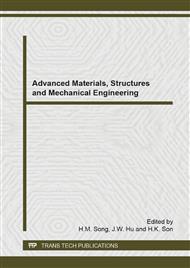p.89
p.95
p.104
p.112
p.117
p.122
p.128
p.137
p.143
Utilization of Mosaic Sludge Waste into Fired Clay Brick: Properties and Leachability
Abstract:
Brick is one of the most common masonry units used as building material. Due to the demand, different types of waste have been investigated to be incorporated into the bricks. Many types of sludge have been incorporated in fired clay brick for an example marble sludge, stone sludge, water sludge, sewage sludge and ceramic sludge. The utilization of these waste materials in fired clay bricks usually has positive effects on the properties such as lightweight bricks with improved shrinkage, porosity, and strength. Therefore, the objective of this study is to incorporate different percentages of mosaic sludge and investigate heavy metals leachability from the mosaic sludge brick. Heavy metals leachability was conducted by using toxicity characteristic leaching procedure (TCLP). Physical and mechanical properties were also determined which are compressive strength, shrinkage, density and initial rate of suction. From the results obtained, it shows that fired clay brick with 5% of mosaic sludge obtained the best result with highest compressive strength and low initial rate of suction (18.76N/mm2 and 10.08 g/mm2) respectively. Nevertheless, all the other properties for all bricks incorporated with different percentages of mosaic sludge were also complied with the BS 3921:1985 standard. The results also demonstrated that the leachability of potential heavy metals in mosaic brick were complied with USEPA (1996) and EPAV (2005a) regulatory limit. In conclusion, mosaic sludge could be an alternative low cost material for fired clay brick as well as providing a disposal method for mosaic sludge waste.
Info:
Periodical:
Pages:
117-121
Citation:
Online since:
September 2014
Price:
Сopyright:
© 2014 Trans Tech Publications Ltd. All Rights Reserved
Share:
Citation:


